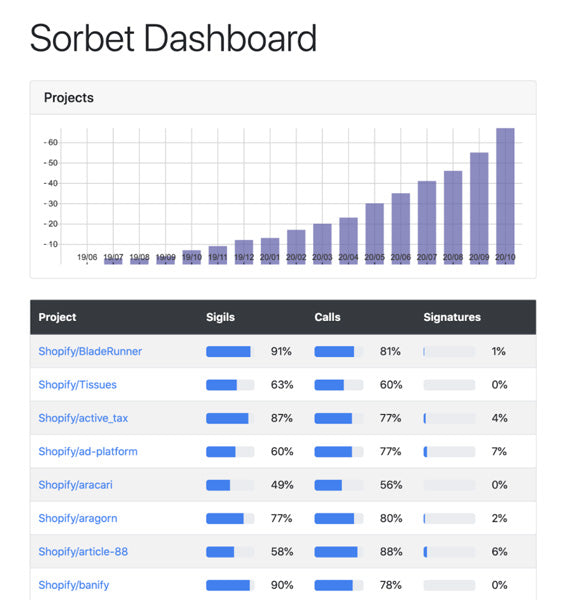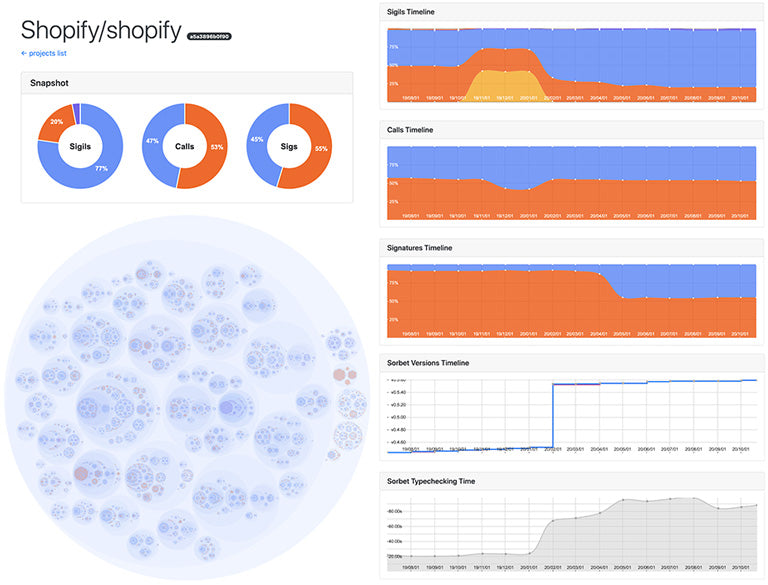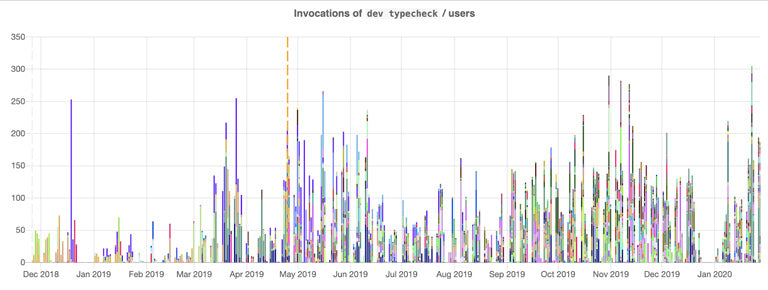On November 25, 2020 we held ShipIt! Presents: The State of Ruby Static Typing at Shopify. The video of the event is now available.
Shopify changes a lot. We merge around 400 commits to the main branch daily and deploy a new version of our core monolith 40 times a day. The Monolith is also big: 37,000 Ruby files, 622,000 methods, more than 2,000,000 calls. At this scale with a dynamic language, even with the most rigorous review process and over 150,000 automated tests, it’s a challenge to ensure everything runs smoothly. Developers benefit from a short feedback loop to ensure the stability of our monolith for our merchants.
Since 2018, our Ruby Infrastructure team has looked at ways to make the development process safer, faster, and more enjoyable for Ruby developers. While Ruby is different from other languages and brings amazing features allowing Shopify to be what it is today, we felt there was a feature from other languages missing: static typing.
The Three Key Requirements for a Typing Solution in Ruby
Even in 2018, typing for Ruby wasn't a novelty. A few attempts were made to integrate type annotations directly into the language or through external tools (RDL, Steep), or as libraries (dry-types).
Which solution would best fit Shopify considering its codebase and culture? For the Ruby Infrastructure team, the best match for a typing solution needs:
- Gradual typing: Typing a monolith isn't a simple task and can’t be done in a day. Our code evolves fast, and we can’t ask developers to stop coding while we add types to the existing codebase. We need flexibility to add types without blocking the development process or limiting our ability to satisfy merchants needs.
- Speed: Considering the size of Shopify’s codebase, speed is a concern. If our goal is to provide quick feedback on errors and remove pressure from continuous integration (CI), we need a solution that’s fast.
- Full Ruby support: We use all of Ruby at Shopify. Our culture embraces the language and benefits from all features, even hard to type ones like metaprogramming, overloading, and class reopening. Support for Rails is also a must. From code elegance to developer happiness, the chosen solution needs to be compatible as much as possible with all Ruby features.
With such a list of requirements, none of the contenders at the time could satisfy our needs, especially the speed requirement. We started thinking about developing our own solution, but a perfectly timed meeting with Stripe, who were working on a solution to the problem, introduced us to Sorbet.
Sorbet was closed-source at the time and under heavy development but was already promising. It’s built for gradual typing with phenomenal performance (able to analyze 100,000 lines per second per core) making it significantly faster than running automated tests. It can handle hard to type things like metaprogramming, thanks to Ruby Interface files (RBI). This is how, at the start of 2019, Shopify began its journey toward static type checking for Ruby.
Treat Static Typing as a Product
With only a three-person team and a lot on our plate, fully typing our monolith with Sorbet was going to be an approach based on Shopify’s Get Shit Done (GSD) framework.
- We tested the viability of Sorbet on our core monolith by only typing a few files, to check if we could observe benefits from it while not impairing other developers’ work. Sorbets’ gradual approach proved to be working.
- We manually created RBI files to represent what Sorbet could not understand yet. We checked we supported Ruby’s most advanced features as well as Rails constructs.
- We added more and more files while keeping an eye on performance ensuring Sorbet would scale with our monolith.
This gave us confidence Sorbet was the right choice to solve our problem. Once we officially decided to go with Sorbet we reflected on how we can reach 100% adoption in the monolith. To determine our roadmap we looked at:
- how many files needed to be typed
- the content of the files
- the Ruby features they used.
Track Static Typing Adoption
Type checking in Sorbet comes in different levels of strictness. The strictness is defined on a per file basis by adding a magic comment in the file, called a sigil, written # typed: LEVEL, where LEVEL can be one of the following:
- ignore: At this level, the file is not even read by Sorbet, and no errors are reported for this file at all.
- false: Only errors related to syntax, constant resolution and correctness of sigs are reported. At this level sorbet doesn’t check the calls in the files even if the methods called don't exist anywhere in the codebase.
- true: This is the level where Sorbet actually starts to type check your code. All methods called need to exist in the code base. For each call, Sorbet will check that the arguments count matches the method definition. If the method has a signature, Sorbet will also check their types.
- strict: At this level all methods must have a signature, and all constants and instance variables must have explicitly annotated types.
- strong: Sorbet no longer allows untyped variables. In practice, this level is actually unusable for most files because Sorbet can’t type everything yet and even Stripe advises against using it.
Once we were able to run Sorbet on our codebase, we needed a way to track our progress and identify which parts of our monolith were typed with which strictness or which parts needed more work. To do so we created SorbetMetrics, a tool able to collect and display metrics about typing coverage for all our internal projects. We started tracking three key metrics to measure Sorbet adoption :
-
Sigils: how many files are typed
ignore,false,true,strictorstrong - Calls: how many calls are sent to a method with a signature
- Signatures: how many methods have a signature

SorbetMetrics dashboard homepage
Each day SorbetMetrics pulls the latest version of our monolith and other Shopify projects using Sorbet, computes those metrics and displays them in a dashboard internally available to all our developers.

SorbetMetrics dashboard for our monolith
Sorbet Support at Scale
If we treat typing as a product, we also need to focus on supporting and enabling our “customers” who are developers at Shopify. One of our goals was to have a strong support system in place to help with any problems that arise and slow developers down.
Initially, we supported developers with a dedicated Slack channel where Shopifolk could ask questions to the team. We’d answer these questions real-time and help Shopifolk with typing efforts where our input was important.
This white glove support model obviously didn't scale, but it was an excellent learning opportunity for our team—we now understood the biggest challenges and recurring problems. We ended up solving some problems over and over again, but it solidified the effort to understand the patterns and decide which features to work on next.
Using Slack meant our answers weren't discoverable forever. We moved most of the support and conversation to our internal Discourse platform, increasing discoverability and broader sharing of knowledge. This also allows us to record solutions in a single place and let developers self-serve as much as possible. As we onboard more and more projects with Sorbet, this solution scales better.
Understand Developer Happiness
Going further from unblocking our users, we also need to ensure their happiness. Sorbet and more generally static typing in Ruby wouldn’t be a good fit for us if it made our developers miserable. We’re aware that it introduces a bit more work, so the benefits need to balance with the inconvenience.
Our first tool to measure developers’ opinions of Sorbet is surveys. Twice a year, we send a “Typing @ Shopify” survey to all developers and collect their sentiments regarding Sorbet’s benefits and limitations, as well as what we should focus on in the future.

Some responses from our “Sorbet @ Shopify” surveys
We use simple questions (“yes” or “no”, or a “Strongly Disagree” (1) to “Strongly Agree” (5) scale) and then look at how the answers evolve over time. The survey results gave us interesting insights:
- Sorbet catches more errors on developer’s pull requests (PR) as adoption increased
- Signatures help with code understanding and give developers confidence to ship
- Added confidence directly impacted the increasing positive opinion about static typing in Ruby
- Over time developers wanted more code and more projects to be typed
- Developers get used to Sorbet syntax over time
- IDE integration with Sorbet is a feature developers are rooting for
Our main observation is that developers enjoy Sorbet more as the typing coverage increases. This is one reason that's increasing our motivation to reach 100% of files at typed: true and maximize the amount of methods with a signature.
The second tool is interviews with individual developers. We select a team working with Sorbet and meet each member to talk about their experience using Sorbet either in the monolith or on another project. We get a better understanding of what their likes and dislikes are, what we should be improving, but also how we can better support them when introducing Sorbet, so the team keeps Sorbet in their project.
The Current State of Sorbet at Shopify
Currently, Sorbet is only enforced on our main monolith and we have about 60 other internal projects that opted to use Sorbet as well. On our main monolith, we require all files to be at least typed: false and Sorbet is run on our continuous integration platform (CI) for every PR and fails builds if type checking errors are found. We’re currently evaluating the idea of enforcing valid type checking on CI even before running the automated tests.

Typing coverage metrics for Shopify’s monolith
As of today, 80% of our files (including tests) are typed: true or higher. Almost half of our calls are typed and half of our methods have signatures. All of this can be type checked under 15 seconds on our developers machines.

Files strictness map in Shopify’s monolith
The circle map shows which parts of our monolith are at which strictness level. Each dot represents a Ruby file (excluding tests). Each circle represents a component (a set of Ruby files serving the same application concern). Yes, it looks like a Petri dish and our goal is to eradicate the bad orange untyped cells.

Shopify projects using Sorbet
Outside of the core monolith, we’ve also observed a natural increase of Shopify projects, both internal and open-source, using Sorbet. As I write these lines, more than 60 projects now use Sorbet. Shopifolks like Sorbet and use it on their own without being forced to do so.

Manual dev tc runs from developers machine on our monolith in 2019
Finally, we track how many times our developers ran the command dev tc to typecheck a project with Sorbet on their development machine. This shows us that developers don’t wait for CI to use Sorbet—everyone enjoys a faster feedback loop.
The Benefits of Types for Ruby Developers
Now that Sorbet is fully adopted in our core monolith, as well as in many internal projects, we’re starting to see the benefits of it on our codebases as well as on our developers. Our team that is working on Sorbet adoption is part of the broader Ruby Infrastructure team which is responsible for delivering a fast, scalable and safe Ruby language for Shopify. As part of that mandate, we believe that static typing has a lot to offer for Ruby developers, especially when working on big, complex codebases.
In this post I focused on the process we followed to ensure Sorbet was the right solution for our needs, treating static typing as a product and showed the benefits of this product on our customers: Shopifolk working on our monolith and outside. Are you curious to know how we got there? Then you’ll be interested in the second part: Adopting Sorbet at Scale where I present the tools we built to make adoption easier and faster, the projects we open-sourced to share with the community and the preliminary results of our experiment with static typing to reduce production errors.
Happy typing!
—The Ruby Infrastructure Team
Wherever you are, your next journey starts here! If building systems from the ground up to solve real-world problems interests you? Visit our Engineering career page to find out about our open positions and learn about Digital by Default.
